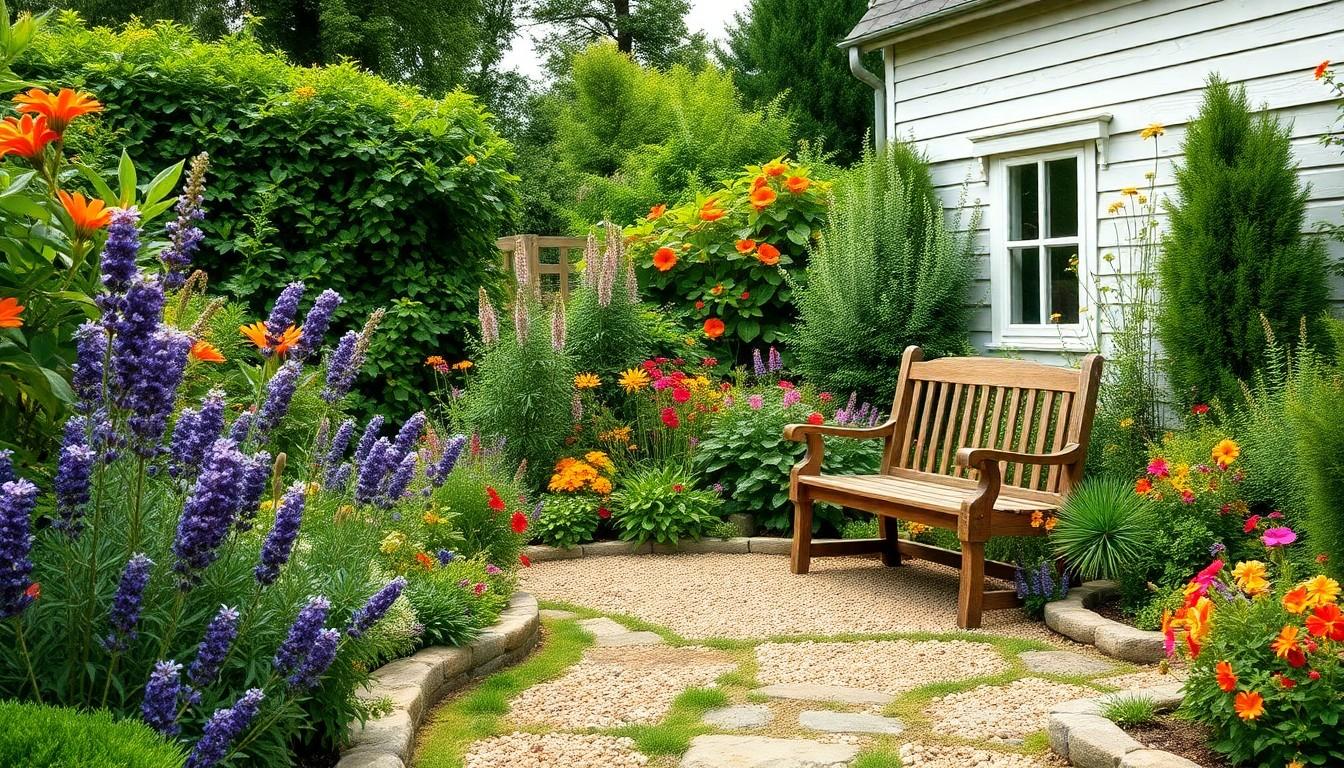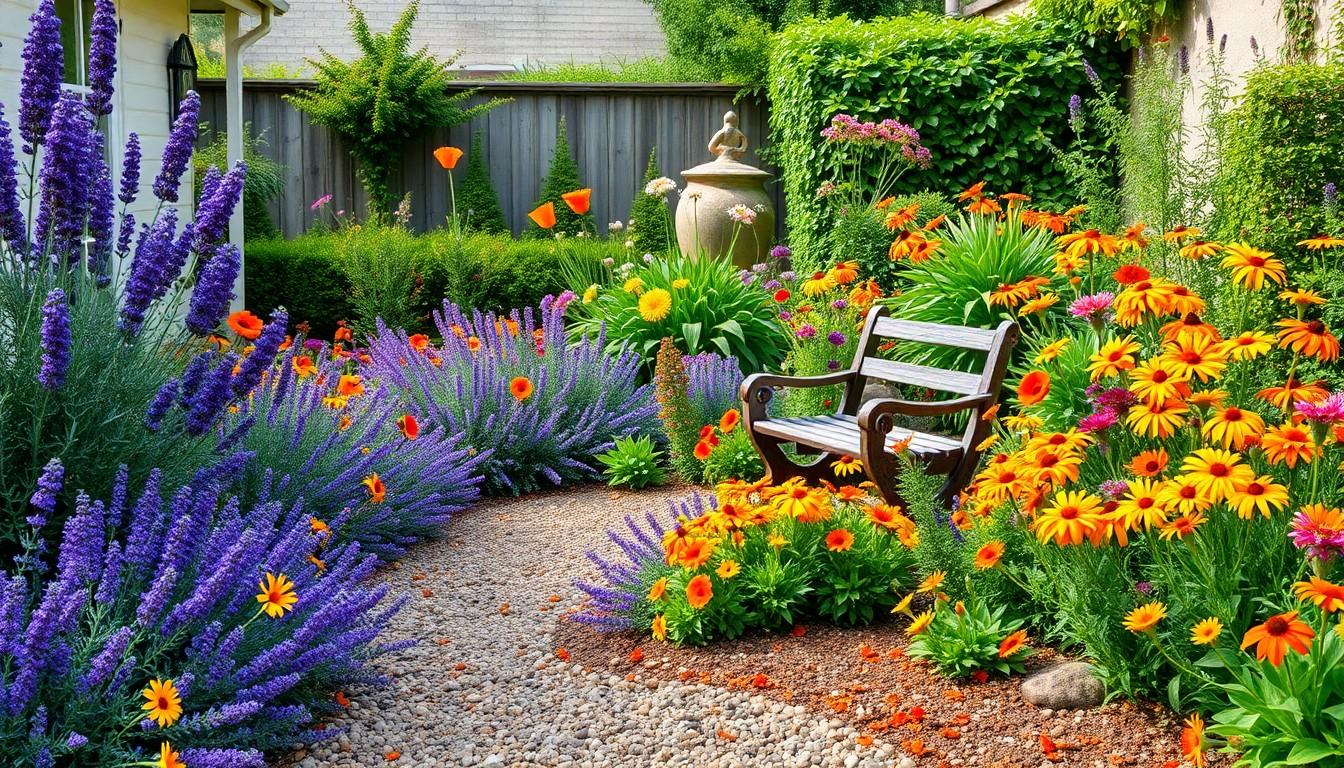Imagine stepping into a garden that feels like a scene from a storybook, yet requires minimal effort to maintain. Low maintenance cottage gardens are the perfect blend of charm and practicality, allowing anyone to enjoy a lush retreat without the constant fuss. With the right plants and design, you can create a whimsical oasis that practically takes care of itself—because who has the time to play the role of a full-time gardener?
These gardens invite a riot of colors and textures while keeping your weekends free for more important things—like lounging with a good book or sipping tea on the porch. From hardy perennials to self-seeding annuals, the possibilities are endless. Dive into this article for delightful ideas that’ll transform any space into a low maintenance paradise, leaving you with more time to smell the roses (or at least, admire them from afar).
Low Maintenance Cottage Gardens Ideas
Low maintenance cottage gardens offer beauty with minimal effort. These gardens focus on simplicity and practicality, making them ideal for busy homeowners. Hardy perennials thrive with little intervention, providing continuous blooms throughout the seasons. Plants like lavender, sedum, and daylilies add vibrant colors while resisting pests and drought.
Self-seeding annuals bring spontaneity to the garden. Flowers such as the California poppy and cosmos spread with ease, creating a natural look without extensive care. Choosing native plants enhances ecological balance, attracting beneficial insects while requiring less water.
Foliage also plays a crucial role in low maintenance gardens. Incorporating evergreens ensures year-round interest, even in winter months. Varieties like boxwood and juniper provide structure without demanding frequent trimming.
Design elements contribute to a relaxed atmosphere. Paths made from gravel or stepping stones reduce maintenance and enhance accessibility. Mulching around plants suppresses weeds and retains moisture, reducing the need for frequent watering.
Creating zones within the garden promotes a sense of organization. Grouping plants with similar needs simplifies care, allowing for efficient watering and fertilizing. Raised beds can further minimize strain on the gardener.
Embracing a hands-off approach fosters a dynamic environment, where nature thrives on its own. Observing the garden’s natural evolution delivers joy without excessive labor. Ultimately, low maintenance cottage gardens transform spaces into inviting retreats, allowing for relaxation and enjoyment.
Key Elements of a Cottage Garden

Cottage gardens thrive on simplicity and character, emphasizing elements that require minimal upkeep while providing aesthetic appeal.
Plant Selection
Selecting plants that require little care is essential for a low maintenance cottage garden. Hardy perennials like lavender, sedum, and daylilies offer vibrant flowers with minimal attention. Incorporating self-seeding annuals such as California poppies and cosmos fosters a natural appearance. Native plants support local ecology and promote sustainability while often flourishing without extensive water or fertilizer. Foliage from evergreens, including boxwood and juniper, adds structure and seasonal interest, ensuring a lively garden year-round. Mixing various heights and bloom times creates visual layers and continuous color.
Hardscape Features
Integrating hardscape features simplifies maintenance and enhances the garden’s charm. Gravel paths allow easy access while reducing weeding and erosion. Patios or seating areas provide places to relax and appreciate the garden’s beauty. Edging with natural stone or reclaimed wood defines garden beds and keeps mulch or soil in place, preventing weeds. Using mulch not only conserves moisture but also suppresses weeds, further easing care. Creating distinct zones within the garden fosters organization, promoting a serene environment that encourages less hands-on work in the landscape.
Designing Your Low Maintenance Cottage Garden
Creating a low maintenance cottage garden begins with thoughtful planning and design. Maintaining simplicity ensures beauty without excessive effort.
Space Planning
Efficient space planning promotes ease of care in garden design. Grouping plants into clusters makes it easier to manage growth and watering. Designing distinct zones for different plant types encourages organization. A blend of hardscape elements like paths and seating areas simplifies navigation. Allowing room for growth prevents overcrowding, which minimizes stress on plants. Incorporating native plants fosters an ecological balance, as these varieties usually thrive in local conditions. Adequate spacing not only enhances aesthetics but also reduces the need for meticulous upkeep.
Color Schemes
Choosing a cohesive color scheme enhances visual appeal while maintaining a relaxed atmosphere. Opting for soothing colors like soft blues, purples, and whites contributes to a calming environment. Incorporating splashes of warmer tones, such as yellows and pinks, adds vibrancy without overwhelming the senses. Using plants with long blooming seasons ensures color throughout the year. Grouping flowers by color creates a harmonious look while simplifying care routines. Integrating foliage plants, such as evergreens, provides consistent shades and shapes when flowers fade. Prioritizing color combinations that complement the surroundings enhances the inviting nature of a cottage garden.
Recommended Plants for Low Maintenance
Selecting the right plants enhances the beauty of a low maintenance cottage garden while minimizing care requirements. Focusing on hardy varieties simplifies upkeep and promotes vibrant growth.
Perennials
Lavender thrives with minimal care, bringing fragrance and color to the garden. Sedum adapts well to various conditions, providing robust foliage and long-lasting blooms. Daylilies excel in sunny spots, offering a striking array of colors each summer. Other excellent options include black-eyed Susans and catmint, both known for their resilience and flower production. Native plants like coneflowers also attract pollinators while requiring little attention. Each of these perennials ensures continuous beauty throughout the growing seasons.
Annuals
Self-seeding annuals enrich low maintenance gardens with spontaneity. California poppies bring bold orange splashes, easily creating cheerful patches. Cosmos stand out with their airy blooms and often reseed themselves for future displays. Nasturtiums offer vibrant colors while deterring pests without extra effort. Sunflowers add vertical interest and typically require minimal care. Each of these annuals contributes charm and personality to the garden, allowing nature to enhance its appeal effortlessly.
Tips for Maintenance
Effective maintenance strategies simplify the upkeep of a low maintenance cottage garden. Employing the right techniques ensures that the garden remains vibrant and healthy.
Watering Strategies
Water efficiently by using a drip irrigation system or soaker hoses. These methods deliver moisture directly to the roots, reducing evaporation. Grouping plants with similar water needs together conserves resources. During dry spells, watering in the early morning minimizes water loss. Consider using rain barrels to collect natural precipitation, promoting sustainability. Focus on deep watering rather than frequent shallow sprays to encourage strong root growth.
Pruning and Weeding
Prune plants minimally to maintain shape and promote airflow. Selective cutting helps manage growth without excessive labor. Implement a consistent weeding schedule to prevent invasive species from taking over. Mulching around plants suppresses weed growth and retains moisture. Spotting weeds early makes removal easier. Choose tools designed for efficient weeding to reduce strain and increase effectiveness.
Achievable Goal for Anyone
Creating a low maintenance cottage garden is an achievable goal for anyone seeking beauty without the burden of constant care. By selecting hardy perennials and self-seeding annuals, gardeners can enjoy vibrant blooms with minimal effort. Incorporating native plants not only enhances the garden’s charm but also supports local wildlife.
Thoughtful design elements like gravel paths and strategic plant groupings simplify maintenance while adding character. With the right planning and plant selection, it’s possible to cultivate a serene outdoor space that thrives with little intervention. Embracing a hands-off approach allows nature to flourish, turning any garden into a delightful retreat.

